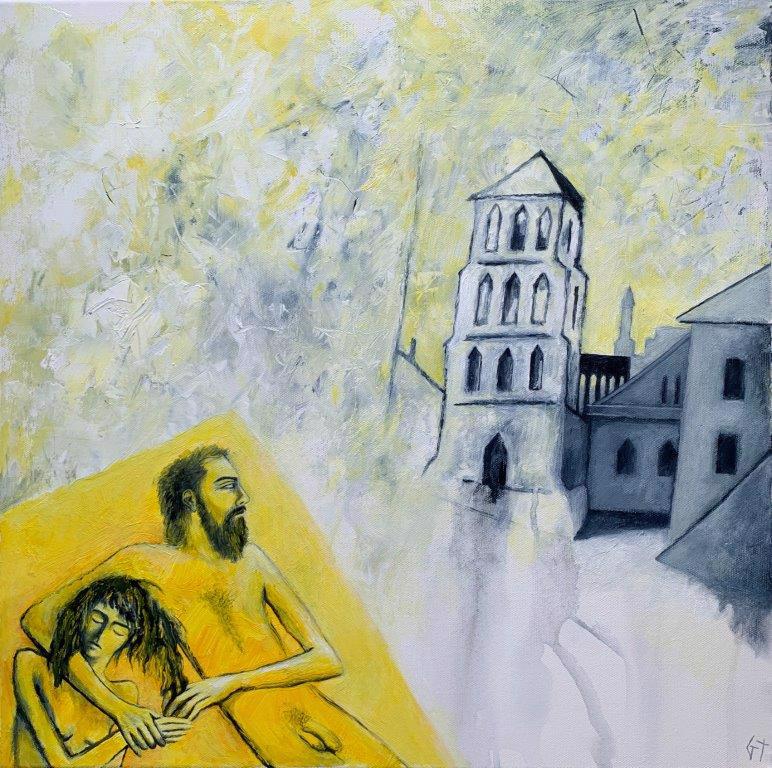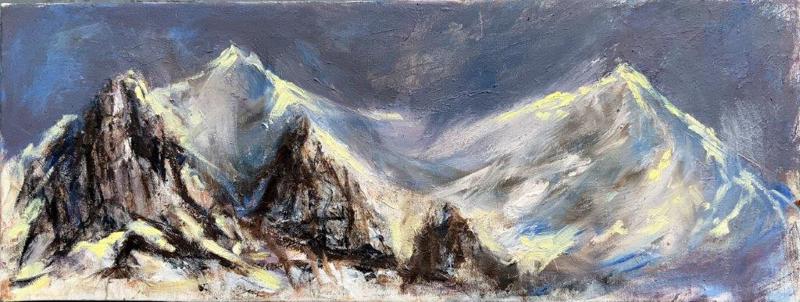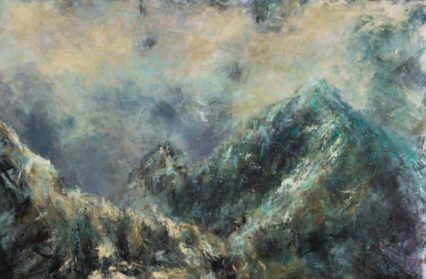Art as an Antidote, recently shown at Oriel Môn, brought together two very different artists who both recognise ‘the singular power of Art to become a kind of saviour’. James Lloyd reviewed the exhibition and shared his thoughts on the works created by Gilly Thomas and Louise Morgan.
What is fascinating about this exhibition is the stark contrast between the artwork of its contributors, Gilly Thomas and Louise Morgan. They appear to be in opposition to each other in content and style, Thomas’ work expressing emotional mindscapes, dreamlike and Freudian, while Morgan depicts the outward landscapes of North Wales, layered with the emotions that they conjure. Yet both contributors’ artwork draws you into an emotional response, both expressions of human experience and emotion, translated into brush strokes and imagery.
Nothing is certain with Gilly Thomas’ artwork, though they undoubtedly express the internal. They are Freudian in nature, uncanny. What is immediately striking is the use of primitive, primary colours. Bright blocks of yellows and internal reds, dark night blues, black and white immediately express an unmistakably surreal and dreamlike quality. They are the primary colours shared by the mythological stories, stories that undeniably express a universal psychology and deep truth. Also similar to myth, the paintings are populated with figures that you could not always describe as human or animal; dysmorphic and thin, or animals that are anthropomorphised with human-like eyes, hands and expressions that evoke the rock and cave art of our ancestors. Often sleeping figures project their dreams onto the canvas, as in Once, where a man looks beyond the bed to a church looming over his bed. Similarly, in Mascot, an artist stands looking at an artwork they have painted, the artwork seemingly more real than the reality they stand in. The paintings together convey art and dreams as the same, both projections of the internal self that can provide greater clarity to the world around us. Both dreams and art provide a surreal space beyond the physical to create unlikely associations, new ways to discern and enrich the meaning of our lived experience.

It is not always clear what that meaning is, however. When looking into these mindscapes you feel an emotion or sometimes contradictory emotions rising to meet them, but it is not always clear what that feeling is. Returning to Once, the man dreams the church, but the emotion it invokes is obscure. The church seems weighted with foreboding and dread, but it’s unclear why, similar to Andrew Wyeth’s Christina’s World. Oddity Steps Gently on the Earth depicts a nightmarish creature emerging into a meadow from the darkness. The Oddity is four legged, with long and thin limbs that are unsettling and anxiety inducing, yet its abstract face is endearing and innocent; an irregular triangle with horns, two circular eyes suspended on a black string look straight at you with an innocent curiosity. Emerging from the darkness, it lightly steps upon a small stone in the meadow that casts a shadow. The Oddity’s lack of shadow implies that itself is a shadow figure of the mind, and the contradictory emotions it conjures conveys the duality of their nature, a shapeshifter archetype. The Oddity is the friend or foe we judge it to be.
This obscurity of meaning is absent from Louise Morgan’s artwork. Her paintings of the land and seascapes of North Wales throughout the year are imbued with an undeniable wonderment that borders on the sacred. What you feel when looking at these paintings is the same rush of emotions that you would being there with Morgan as she painted them, the rushing of the sea or wind, the mountain rising above you, the sense of a living, breathing landscape.
In Morgan’s paintings, the landscapes are grand, ancient and majestic. The Crib Goch series, painted around Pen y Pass, depicts the mountain at different times of the year, in different colours and weathers, the purple heather blush of late summer, or the white winter with cool blue slopes, its ridges made peach in the afternoon sun. Another uses a mixed medium of scratched paint, ink and charcoal to depict Crib Goch in dark stormy colours. The motions of the brushes convey a kinetic energy to the day, a wild sense of movement akin to those of Van Gogh’s landscapes that appear to move in front of you. Each painting has different colours, different atmospheres and uses different mediums to capture not only the landscape but the emotion they conjure. Bare bones of Cwm Idwal depicts Cwm Idwal in winter, Llyn Idwal and the steep mountain walls distilled into black and white clarity. The image, as are the mountains in this state, feels still, muffled yet roaring. It’s a calming image. The subtle painting techniques give the lake its stillness, almost a grey mirror of its surrounds. The brush strokes form the ridges and impressions, white paint brushed downwards shows the cool gentle smooth flow of water out of the lake. I was a little saddened to see a red dot on its plaque, the painting sold.

As there is a sense of movement to Morgan’s paintings, there is also a timelessness to these landscapes that makes insignificant the human efforts upon them. In each painting, the human effort on the landscape is made insignificant against the magnitude of earth, water and rock. In Crumbling Slate Cathedral, the mountains loom over an old quarry building, its roof long gone. There is an overwhelming sense of absence, a quiet stillness. This had once been a fine building, it had once been the focus. Painted with harder edges and greater detail than the mountains that loom around it makes it feel smaller somehow, miniature. Its triangular gable walls are a fragile imitation of the mountains that loom behind it. The naming of the building as a cathedral in the painting’s title eludes to the piousness of the community that worked there, a theme returned to in the Capel Cwm Orthin series of paintings. The series similarly shows the ruins of a mining community’s chapel, dwarfed by the valley it was built from. Religion, like the industries of rock and ore, had grown and vacated these landscapes in a millisecond of deep time, leaving the presence of something far greater. There is no sense of loss in these paintings, only of beauty; a calming and reassuring acceptance of our relative insignificance outside an egotistical civilisation. As said in Ecclesiastes 1:4, ‘Men go and come, but earth abides’.
Gilly Thomas and Louise Morgan could not be more different in style and subject. There is no question as to what we see in Thomas’ mindscapes, however abstract, yet what we feel is obscure. Morgan’s work in opposition conjures unmistakeable awe in all its colours, yet the kinetic movement of brush strokes leaves room for the imagination. For both artists, it is this space for interpretation of what we see or feel that makes their art so compelling. Like the landscapes that Morgan paints or the emotional duality of Thomas’ work, they call to an innate need to respond, to rise to meet them in some way. These are humbly my own responses, coloured by my own experiences and interests, those of myth and dreams, mountains and the sacred. What makes the art of Gilly Thomas and Louise Morgan so special and so connected is the space for your own responses too.
Art as an Antidote by Gilly Thomas and Louise Morgan was shown at Oriel Môn from the 11th of September to the 31st of October 2021. For more information, click here.
Header image: Art as an Antidote | Crib Goch 4, Follow the Light Path by Louise Morgan (mixed media on canvas, top layer oil)












